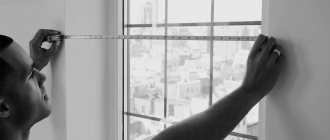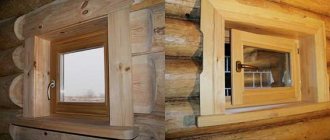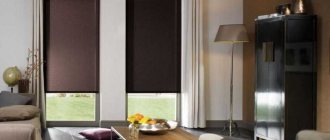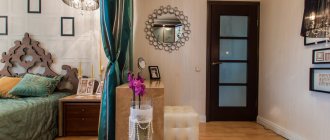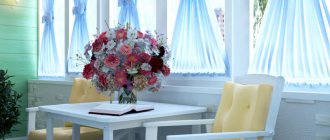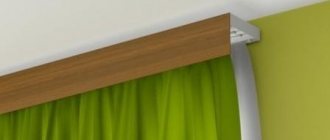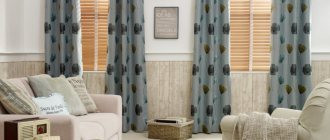Before answering the question of what types of curtains there are, let’s first consider the main elements that make up window curtains. The curtain can be either simple, consisting of one sheet, or containing a set of decorative elements. It is these elements that set the style of the curtain, which in turn sets the style of window design and affects the design of the room as a whole.
The names of the component parts - elements of curtains - will appear later when describing the types of curtains. Therefore, you need to have an idea about them. So look at the picture:
Basic elements in curtains
Lambrequin - placed at the top of the window design composition and located parallel to the floor or ceiling. The texture of lambrequins can be either straight or with folds. There can be many folds or one in the center of the lambrequin. Single folds can be rectangular, triangular or conical. You can hang the lambrequin either by the cornice or directly on the curtain fabric. The lambrequin can also be stretched over a frame made of metal, wood or plastic. This frame is fixed to the cornice. The main function of lambrequins is decorative; they complete the composition and make the curtains look more balanced and complete.
Drapes are the main element in curtains. Curtains are made from dense, usually opaque fabrics. Curtains can have double-sided decoration on both the front and back of the fabric. The back part can be a contrasting color in relation to the face of the curtain, or contain a pattern different from the front one. The main function of curtains is to protect the room - during the day from bright light from the windows, and in the evening from prying eyes from the street.
Tiebacks are usually paired elements located along the side edges of the curtain. Designed to fix curtains when open. They can also be used for draping - folding curtains and drapes. There are also single pickups. They fix the curtain to one edge.
Curtains - can be used as an additional element in the window composition or independently. Curtains are made from light transparent or translucent fabric. Since curtains allow daylight to pass through well, there is no need to open them during the daytime. Curtains closed during the day will protect the room well from onlookers outside the window. And in the evening, curtains will take on this role.
That's probably all there is to the basic elements.
And one more important point. When choosing the type of curtains, do not forget that for different curtains you will also need curtain rods corresponding to the curtains. I described in detail what kind of cornices there are in this article. Now let's figure out what types of curtains there are.
Curtains, according to the type of opening, can be divided into three main types:
- sliding,
- lifting
- stationary
Curtains
These are long rectangular pieces of fabric that, when unfolded, turn into a straight fabric, and when gathered, they gather in folds resembling waves.
The optimal length is from the eaves to the floor. Thick fabric for window curtains protects the room from sunlight. The highest quality curtains are made from natural fabrics.
Types of sliding curtains
The sliding type of curtains involves opening the curtains to the sides of the window. As a rule, the upper part of such curtains is fixed vertically to the cornice. Sliding curtains can be adjusted in width and height.
Classic straight curtains
This type of curtains is the most widespread. Classic straight curtains consist of thick curtains and light curtains mounted vertically on a cornice. Lined curtains can be used.
Crossed curtains
The panels of this type of curtains are fixed on opposite sides of the cornice. The fabric of the curtains goes cross to cross. Such curtains can consist of either two halves or one sheet that is thrown over the cornice.
Cafe curtains
This type of curtain refers to short curtains, the length of which does not fall below the top edge of the window sill. Cafe curtains are attached to a cornice or bar located in the middle of the window. The fabric can be either dense or transparent. In addition, various decorative elements can be used - buttons, loops, eyelets, etc. The height of the cafe curtains allows light to enter the window even when closed.
Curtains with lambrequins
From the name it is clear that this type of curtains is complemented by decorative elements - lambrequins. Lambrequins can be attached directly to the curtain fabric or have independent fastening elements. Lambrequins can have both a hard and soft design. Wooden slats can be used as the basis for a rigid structure, or braid for a soft one. For curtains with lambrequins, it is optimal to use a rail curtain rod, consisting of several rows for fastening the curtains. This type of curtains is used in classic interiors.
Japanese curtains
This type of curtains has a rigid structure. The curtains are fixed to the frame. Usually the width of one canvas does not exceed 1 meter. Japanese curtains are not adjustable in height, but move along the width of the window. Such curtains are very similar to screens, which are used as light partitions in a room. The use of Japanese curtains is appropriate in Japanese-style and minimalist interiors
Thread curtains (muslin)
This type of curtain is made of heavy silky threads. Due to the weight, the threads do not get tangled. Thread curtains can also be used to decorate doors or zoning space in the interior
Photo curtains
This is a fairly new type of curtain for the Russian market. For their manufacture, dense light-proof fabrics are used, for example, blackout or satinette. For those who like to sleep in the morning, these curtains will be a good surprise. The design is applied to the fabric using digital printing. Therefore, to order, you can make almost any design you like on your curtains. In addition, manufacturers make bed linen and tablecloths with photo-printed designs, which makes it possible to tie together the composition in the interior. The curtains open to the sides like regular straight curtains.
Mounting method
It is not enough to buy luxurious fabric and decide on the drapery; you will also have to decide how the textiles will be held on the cornice. This seemingly trifle can give the composition a complete character or ruin the entire design. For the chosen method, you will need to buy a suitable cornice: wall or ceiling, and install it.
- Loops - they are sewn from the same material as the curtains themselves, and either both ends of the loop are sewn on, or only one, and the other is secured with a button or Velcro.
- A drawstring is a fold stitched at the top that fits onto a round placket.
- Rings – they are attached to the curtain itself with hooks and are suitable for light curtains.
- Eyelets are metal or plastic rings that are fixed into the fabric itself. Thanks to this, they can withstand even heavy fabric and form the same beautiful folds.
- Braid is sewn to the back of the product and is invisible from the front. Forms smooth, neat gathers.
I advise you to choose the type of fastening based on the density of the curtains. Thus, braid and hooks can only withstand weightless curtains. And for heavy fabrics it is better to use eyelets, loops or rings.
Types of lifting curtains
The next type of curtains combines the method of opening them. Lifting curtains open upward using special mechanisms. Lifting curtains are not adjustable in width; they have a fixed size, usually equal to the width of the window opening. Lifting curtains are also called flat, apparently because when opened, the curtain canvas moves along the plane of the window.
Austrian curtains
This type belongs to flat curtains. When raised, Austrian curtains form elegant wave-like folds. When lowered, the curtains hang straight and are slightly gathered at the bottom.
French curtains
This look is very similar to Austrian curtains. The main difference between French curtains is that they have small horizontal folds both when raised and lowered. These curtains are usually made of lightweight fabric. French curtains are adjustable only in height
Roman curtains
This type of curtains is also classified as flat curtains. They are made of thick fabric. Horizontally at equal distances, the fabric is stitched across the entire width and forms narrow horizontal pockets into which special strips are inserted.
The upper part of the Roman blind is firmly fixed to a special cornice, which is equipped with a lifting mechanism.
Roman blinds are raised using cords that are threaded into rings on the back of the curtain. When raised, the curtain forms horizontal folds.
Roman blinds are usually used in simple interiors or in the kitchen.
Some types of Roman blinds
English curtains
This type of curtain is a type of Roman blind. The main difference between English curtains and Roman curtains is their pomp. The pomp is created by the additional width of the fabric. When assembling the curtains, lush bow folds are formed.
Roller blinds
This type of curtain is a flat canvas that is assembled upward using a special mechanism. Using this mechanism, the curtain is rolled into a roll, which is hidden under the box at the top of the cornice. For lifting, a thread or chain is used, which can be either on the left or on the right side of the roller blind. The curtain lifting mechanism provides for fixing the curtain at different heights. The fabric for making roller blinds is usually quite dense. It can be either plain or with a pattern.
The advantage of roller blinds is their compactness. It does not protrude far from the window, and is often even in the frame. Such curtains will fit well into a minimalist interior.
Pleated curtains
This type of curtains came from Germany. They are often called pleated blinds. Indeed, pleated curtains look similar to horizontal blinds. But instead of the slats used in blinds, curtains use thick fabric with pleats. Pleated curtains can be used on windows with both simple and complex shapes. Fabrics for pleated curtains are treated with a protective compound that helps the fabric keep its shape and protects it from fading and dust. You can find pleated curtains made of paper.
Style and color
Curtains are one of the central objects of the room, since they are usually quite voluminous, immediately catch the eye and should be combined with the surrounding environment. Textiles should be selected based on the design of the entire living space.
- The classic interior will be decorated with the usual sliding curtains made of thick curtain fabric. A combination of several colors of fabric and the use of tiebacks and lambrequins are acceptable.
- Baroque is characterized by the same features as classicism, only even more elaborate: a large number of folds and flounces, additional decor, expensive materials. Characteristic colors: gold, emerald, ruby, silver.
- The now popular minimalism and Scandinavian style will ideally complement simple curtains without images of white, gray or beige. Lifting options without flashy design will also look organic here.
- High-tech also does not tolerate complex forms. Monochromatic products in snow-white, steel, and brown colors will suit it.
- Natural fabrics and pastel shades of blue, green, and silver will fit well into Provence. Often there is an ornament, usually small flowers.
- For oriental finishes, of course, Japanese models with characteristic ethnic images are shown. It is possible to use roller blinds or plain curtains without complex details.
In addition to the overall style, light and temperature should be taken into account when determining the color of the curtains. So, cool apartments with windows facing north need to bring a bit of warmth, and shades of yellow, light green, gold and brown will help with this. But cool colors of blue, blue and lilac can normalize the atmosphere in a bright room.
Be sure to watch the video (you can rewind the first minute of the video) about choosing basic curtains:
Types of stationary curtains
This type of curtains is united by the impossibility of their movement. The curtain fabric is fixed on the curtain rod and does not require the curtain to move along it. Typically, stationary curtains have a decorative function and serve to decorate the interior. For example, you can use them to create the illusion of a window in a windowless room.
Italian curtains
This type of curtain is a bit like crossed curtains. The peculiarity of Italian curtains is that the curtains are fixed to the cornice without the possibility of their movement from above. To open the curtains, they are simply pulled apart and tied with tiebacks. In this case, the tiebacks or cord for tying are located closer to the top of the curtain. This technique gives the window an interesting frame line and is a “trick” of Italian curtains. Italian curtains are well suited for non-standard windows. For example, arched ones. Sometimes, to pick up curtains, a simple mechanism consisting of rings and braid is used. The mechanism is attached to the back of the curtain.
Imperial curtains
Designers consider this type of curtain to be the most difficult to implement. Imperial curtains are pompous and ceremonial. They will look good in a large room with high ceilings.
Bishop sleeve curtains
Used to make the room look grand. They are made from both light and dense fabrics. To give curtains a more expressive volume, inserts made of tissue paper or padding polyester are sometimes used.
Stained glass curtains
Because of the similarity, this type of curtain is also called hourglass. The upper and lower parts of the curtain fabric are fixed on the cornice. In the center, the curtain fabric is collected using selection. The collection may take the form of a bow. This type of curtains is good to use on small windows in galleries or summer gardens. Hourglasses are also used to decorate doors with glass.
Pleated day night
The “day-night” (blackout) option is distinguished by a combination of two colors or materials. One is light and transparent, the second is dark and dense. They have separate opening mechanisms, thanks to which you can arbitrarily adjust the intensity of natural light. Most often, such systems are installed in children's rooms, bedrooms, and living rooms.
They perform the function of classic curtains, therefore they are self-sufficient. Due to their stylish appearance, day-night systems are becoming increasingly popular. However, they are suitable only for standard rectangular window openings.
Curtains for decoration
I have identified these curtains as a separate type because they do not serve to decorate windows, but to decorate other interior elements.
Curtains for doors and doorways
Curtains for doors can serve several functions
- decorative function - in this case, the curtains simply decorate the doorway and, depending on the style, can make your interior more formal or, conversely, more homely and cozy.
- the function of a partition or curtain between rooms or zones in a room. In this case, the curtain performs the function of a door - it closes the door frame and separates the rooms.
Door curtains can be attached to the cornice above the doorway or directly to the door. Attaching curtains to a door is usually used on doors with glass. An example of such fastening was presented above when describing stained glass curtains.
Canopy curtains
The word canopy comes from the Italian baldacchino, which meant “silk fabric from Baghdad.” The canopy appeared in the ancient East. Then an umbrella made of fabric was worn over the king, which protected him from the sun and prying eyes. Later, the umbrella turned into a portable throne or bed, protected by fabric around the perimeter. In rooms, the canopy was used as a curtain over a throne or a ceremonial seat. Later the canopy found itself in the bedroom. In Rus', our ancestors used a canopy to protect a baby's sleeping place from drafts and insects - hanging the fabric over the baby's cradle.
Currently, canopies are mainly used in bedrooms. The fabric is hung on special structures - or columns around the bed, as well as on a cornice attached to the ceiling above the bed. Canopy curtains will add comfort to your sleeping nest and, if necessary, protection from prying eyes.
Features of materials
There are practically no restrictions on the textiles used to make curtains. Any type of curtains can be made from any type of fabric. The priority aspect of choosing a material is its ability to transmit light.
Thus, the darkest fabrics are used in bedrooms. In some cases, the canvases are even equipped with a special black-out lining - a layer that does not transmit light at all. Moreover, such a curtain can easily be classical, Austrian or even Roman.
Of course, there are still some restrictions, but they are more likely related to the characteristics of the rooms in which the curtains will be hung. For a nursery, kitchen, office or banquet hall, various compositions are required that will take into account the design style of a particular room and the needs of the people living in it. That is, it is better to entrust the choice of a suitable configuration and materials to a specialist.
How to make pleated wallpaper with your own hands
Creative housewives are interested in making unusual curtains with their own hands. Realization of your own creative potential allows you to give the interior a special zest and unique flavor.
What materials will you need?
Let's list what you need to prepare before starting work:
- Paper, non-woven wallpaper intended for painting is best. This material transmits diffused light well, but protects from the scorching sun and prying eyes. The properties of the paper will allow you to form an “accordion” that will keep its neat shape for a long time.
- 2 wooden slats of square section 1x1 cm.
- Ruler.
- A simple pencil.
- Choose from cord, ribbon or rope.
- Awl or hole punch.
- Glue.
- 2 adhesive tapes: 1 - self-adhesive, 2-sided.
- For the latch - a large bead.
Instructions
- The height and width of the window are measured.
- A piece of paper is cut 30-40% longer than the window opening.
- The paper blank is ironed from the inside out with an iron.
- On both sides, use a pencil and a ruler to mark the lines of future accordion folds. Their width is chosen arbitrarily.
- An “accordion” is folded along the marked lines. It is convenient to use a ruler when forming folds. The edge folds should be internal.
- The folded “accordion” in the center is pierced with a hole punch. A cord (ribbon or rope) is passed through the resulting hole. A bead is strung onto the lower end and secured with a knot. The upper end is fixed to the paper with 1-sided tape. On a wide canvas, not 1 but 2 ropes are passed - on the sides, at a distance of about 5 cm from the edge.
- Self-adhesive strips of double-sided tape are glued to the bottom and top strips of paper, to which wooden strips are attached. On top it will be a cornice, and below it will be a weighting material. Although you can do without a strip by attaching the pleated curtain directly to the frame.
When the width of the wallpaper is not enough to cover the entire window, then 2 identical paper strips can be glued together with transparent tape or 2 independent pleated curtains can be formed.
Cleaning and care
Not only the curtain fabric, but also the control mechanism requires some care. Only material impregnated with special compounds that prevent the accumulation of dust and moisture retention requires minimal attention. It is enough to wipe such pleated curtains with a slightly damp cloth once every few months.
Washing fabric is done in water no higher than 30 degrees Celsius; the fabric is simply soaked in a soap solution and then rinsed. Particular care must be taken when handling material coated with a reflective layer.
Dormer windows
Attic windows are most often of non-standard shape, so it is impossible to hang classic curtains on them. Pleated curtains can be installed without any problems, and they don’t take up a single centimeter of scarce space.
Due to their small size and weight, such curtains can be mounted at any angle. When the canvas is in an inclined position, the side strips are fixed. For control, special bars or leashes are mounted - these are handles.
Control
When a fire occurs, the fire alarm system sends a signal to the automatic fire station and to the fire curtain control unit, and it will automatically begin to lower at a speed of about 8-15 centimeters per second. And thus completely localizes the source of fire or smoke.
Often the fire screen is equipped with additional power sources in case of a power outage. Thus, thanks to the backup battery, even when the electricity is turned off, the curtain will fall in time and perform its function.
Installing the product with an accordion
Installing this design is not at all difficult. You need to remember a few tips for installing it:
- Before starting installation, check if your wall is level. If there are holes left between the panel and the tiles, water will begin to penetrate into the bathroom.
- Fasten the panels as straight as possible, otherwise the structure may break.
- Ensure moisture tightness using a moisture-resistant sealant, and not any other.
- Be sure to check the waterproof quality before use.
Accordion curtains are an acceptable cheap option for both shower rooms and windows with doors. Unlike classic analogues in the form of curtains, they practically do not take up space and can be easily removed. Thanks to the plastic base, they can be easily wiped with a damp cloth, so dust will not accumulate in the apartment. So these products are great for those who suffer from dust allergies.
Which cornice is better
In addition to the characteristics of the fabric, you need to pay attention to the cornice. The design should suit the curtain and the interior of the room.
- Among wooden representatives, the most popular option is the classic rod; there is also a more expensive model with a massive strip on the front side and decorative carvings. Suitable for a country house made of timber or for a room in eco, country, Provence, minimalism styles. The color of the cornice can be any: from white to black. Dark ones are ideal for classic, empire and baroque.
- Forged - due to the large number of varieties, metal structures are used in the design of any modern interior. Particularly popular in loft and hi-tech styles. The cornices have an interesting decor: corner connectors, plugs, tips. Possible colors: bronze, bleached gold, copper, stainless steel, onyx, black, satin.
- Plastic structures can imitate a wooden cornice. The base is made of a thin sheet of metal and is covered with a film reminiscent of the texture of wood. The remaining components are made of plastic.
- There are models for installation in a ceiling niche, equipped with a special groove for fixing a decorative tape that will hide rollers and hooks for curtains. The main advantage of plastic models is their low price.
- Strings - used for light curtains. Classification depending on the material: strong threads, stainless steel, polymers, metal cables. Techno, hi-tech, country, Provence, and minimalism styles will look harmonious in a room. The string design is almost invisible and is often used in small spaces.
The color of the cornice depends on the decoration of the walls and the type of curtain. For a small space, it is better to choose light, laconic models that will not attract attention.
A few more tips:
- a dark cornice looks beautiful in combination with light curtains, or you can choose tones that are close to each other;
- the cornice holders should blend into the color scheme of the room; often a shade similar to the wall decoration or identical to the base of the cornice is chosen;
- to create maximum privacy and good protection from the sun, a two-tier cornice, which is equipped with a rounded track or strip, will help;
- The cornice must match the density and size of the curtains; you should not hang light curtains on massive structures.
Installation of the curtain rod depends on the type of curtains. Installation methods: on the wall, ceiling, window opening. A curtain attached to the ceiling will visually increase the height of the room. Roman, roller and blinds can be installed on the window sash.
Accordion blinds
One of the options for creating a beautiful and functional design of window units is accordion pleated blinds. In the plane of the light opening, such a product is held by guide cords. On both sides, the panel is fixed on aluminum cornices; when folded, it forms an almost invisible dense package with a thickness of only about 5 cm. Elastic folds 10-50 mm wide are formed on the fabric by impregnating it with a special compound and processing it on special equipment. This technology ensures clear pleating lines for many years.
With horizontal folds
From the outside, such pleated curtains look exactly like blinds, but they do not have individual slats, only a continuous piece of material that is assembled into a neat accordion by a tensioning mechanism. A professionally assembled structure will cost more than regular curtains, but the effect will be amazing!

